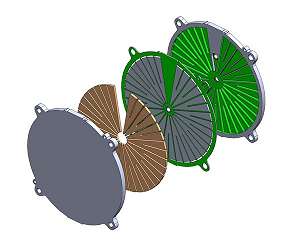On Earth, plants and ocean microbes use sunlight to turn carbon dioxide, or CO2, into sugars for energy. Humans don’t have that ability, at least not yet.
On Mars, there aren’t plants and oceans, but there is an abundance of CO2. NASA’s CO2 Conversion Challenge invited the public to come up with ways to convert this principle component of the Martian atmosphere into sugar, which astronauts could use to make useful products – anything from plastics, adhesives, and fuels to food and medicine.
Now, three teams of solvers have demonstrated prototype systems capable of converting CO2 from the air into glucose and other useful sugars. Teams Air Company of Brooklyn, New York; Hago Energetics Inc. of Thousand Oaks, California; and SSwEET from the University of California, Berkeley will take home equal shares of the $650,000 base prize.
“The CO2 Conversion Challenge began in 2018 to incentivize the public to recreate an invisible process plants do regularly with a non-biological system,” said Monsi Roman, manager of Centennial Challenges. “Despite many obstacles, three teams developed beneficial technologies that could enable humans to create valuable products from the Martian environment.”
All three teams also won bonus prizes for designing systems with spaceflight in mind. The judging panel evaluated each submission for bonus points based on efficiency, scalability, and reliability. Air Company will receive $50,000, while Hago Energetics and team SSwEET will receive $25,000 each.
Air Company’s three-step process begins by combining CO2 and hydrogen to make methanol. Removing hydrogen then turns the methanol into formaldehyde, a colorless and strong-smelling chemical used to make building materials and cleaning agents. The third chemical reaction produces a simple sugar called D-glucose.
Hago Energetics’ system used a similar thermochemical process to produce D-glucose and other sugars. Its four-step process first uses electricity to split water into hydrogen and oxygen. The CO2 and hydrogen combine to create methanol, and then hydrogen is removed to produce formaldehyde. The final chemical reaction creates D-glucose.
Team SSwEET – short for Space-Sugar with Electrochemical Energy Technology – demonstrated that glycolaldehyde, a compound that CO2 can produce when broken down by electrical energy, can “autocatalyze” sugars like glucose. That means the chemical reaction producing the sugars also makes a product that can initiate the same reaction again, creating a cycle.
These types of systems could allow future explorers to use readily available resources at a destination’s environment.
Learn about opportunities to get involved and provide solutions to NASA
Related Links
NASA’s CO2 Conversion Challenge
Bio Fuel Technology and Application News
|
We need your help. The SpaceDaily news network continues to grow but revenues have never been harder to maintain. With the rise of Ad Blockers, and Facebook – our traditional revenue sources via quality network advertising continues to decline. And unlike so many other news sites, we don’t have a paywall – with those annoying usernames and passwords. Our news coverage takes time and effort to publish 365 days a year. If you find our news sites informative and useful then please consider becoming a regular supporter or for now make a one off contribution. |
||
|
SpaceDaily Contributor $5 Billed Once credit card or paypal |
SpaceDaily Monthly Supporter $5 Billed Monthly paypal only |
|

![]()
Faster and cheaper ethanol-to-jet-fuel on the horizon
Richland WA (SPX) Aug 20, 2021
A patented process for converting alcohol sourced from renewable or industrial waste gases into jet or diesel fuel is being scaled up at the U.S. Department of Energy’s Pacific Northwest National Laboratory with the help of partners at Oregon State University and the carbon-recycling experts at LanzaTech.
Two key technologies power the energy-efficient fuel production units.
A single-step chemical conversion streamlines what is currently a multi-step process. The new PNNL-patented catalyst c … read more